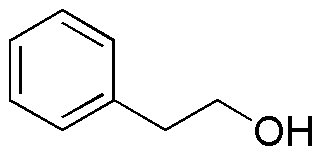2-Phenylethanol is widely utilized in research focused on:
- Fragrance Industry: This compound is a key ingredient in perfumes and cosmetics, providing a pleasant floral scent that enhances product appeal.
- Food and Beverage Industry: It serves as a flavoring agent, imparting a sweet, rose-like flavor to various food products, making it popular in confectionery and beverages.
- Pharmaceuticals: 2-Phenylethanol is used as a solvent and a precursor in the synthesis of various medicinal compounds, aiding in the development of new drugs.
- Biotechnology: This chemical acts as a natural preservative due to its antimicrobial properties, helping to extend the shelf life of biological samples and products.
- Research Applications: In laboratories, it is employed as a reagent in organic synthesis, facilitating the creation of complex molecules in various research projects.
General Information
Properties
Safety and Regulations
Applications
2-Phenylethanol is widely utilized in research focused on:
- Fragrance Industry: This compound is a key ingredient in perfumes and cosmetics, providing a pleasant floral scent that enhances product appeal.
- Food and Beverage Industry: It serves as a flavoring agent, imparting a sweet, rose-like flavor to various food products, making it popular in confectionery and beverages.
- Pharmaceuticals: 2-Phenylethanol is used as a solvent and a precursor in the synthesis of various medicinal compounds, aiding in the development of new drugs.
- Biotechnology: This chemical acts as a natural preservative due to its antimicrobial properties, helping to extend the shelf life of biological samples and products.
- Research Applications: In laboratories, it is employed as a reagent in organic synthesis, facilitating the creation of complex molecules in various research projects.
Documents
Safety Data Sheets (SDS)
The SDS provides comprehensive safety information on handling, storage, and disposal of the product.
Product Specification (PS)
The PS provides a comprehensive breakdown of the product’s properties, including chemical composition, physical state, purity, and storage requirements. It also details acceptable quality ranges and the product's intended applications.
Certificates of Analysis (COA)
Search for Certificates of Analysis (COA) by entering the products Lot Number. Lot and Batch Numbers can be found on a product’s label following the words ‘Lot’ or ‘Batch’.
*Catalog Number
*Lot Number
Certificates Of Origin (COO)
This COO confirms the country where the product was manufactured, and also details the materials and components used in it and whether it is derived from natural, synthetic, or other specific sources. This certificate may be required for customs, trade, and regulatory compliance.
*Catalog Number
*Lot Number
Safety Data Sheets (SDS)
The SDS provides comprehensive safety information on handling, storage, and disposal of the product.
DownloadProduct Specification (PS)
The PS provides a comprehensive breakdown of the product’s properties, including chemical composition, physical state, purity, and storage requirements. It also details acceptable quality ranges and the product's intended applications.
DownloadCertificates of Analysis (COA)
Search for Certificates of Analysis (COA) by entering the products Lot Number. Lot and Batch Numbers can be found on a product’s label following the words ‘Lot’ or ‘Batch’.
*Catalog Number
*Lot Number
Certificates Of Origin (COO)
This COO confirms the country where the product was manufactured, and also details the materials and components used in it and whether it is derived from natural, synthetic, or other specific sources. This certificate may be required for customs, trade, and regulatory compliance.


